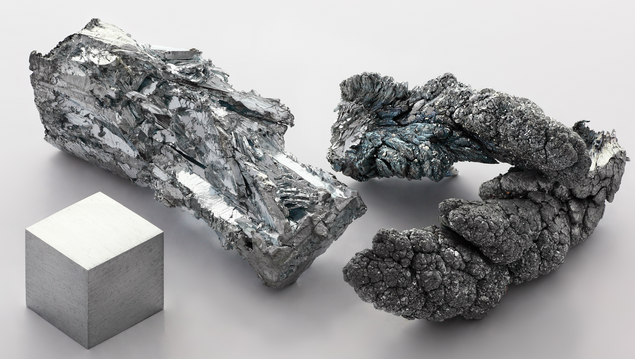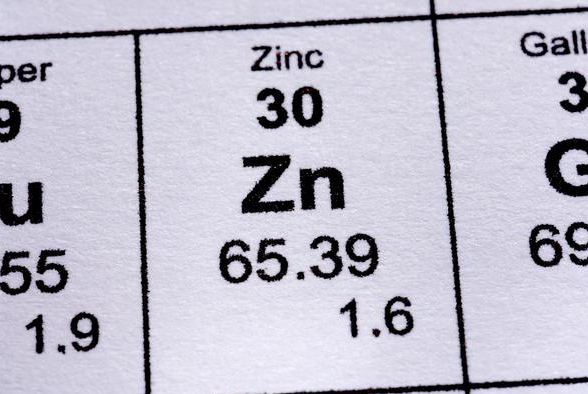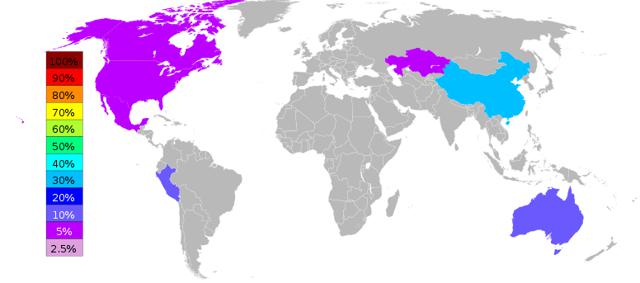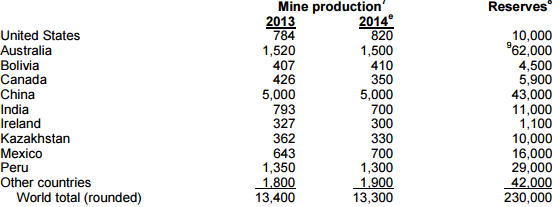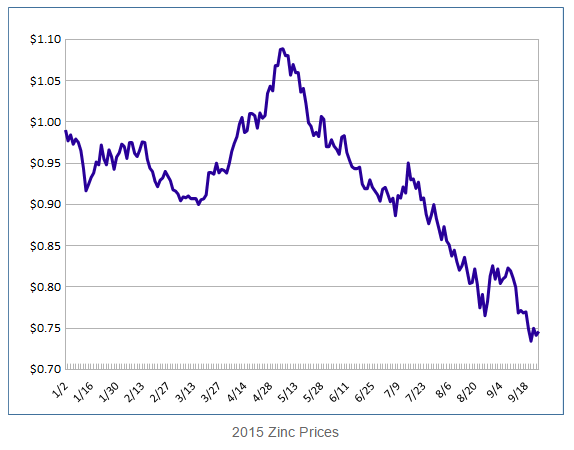Nicholas Bodnar, Nicholas Bodnar (570 clicks)
Nano-cap, micro-cap, deep value, contrarian
Profile| Send Message|
Follow (664 followers)
Performance
Playing The Deficit In The Zinc Market For Expected Higher Prices
Oct. 8, 2015 4:32 AM ET | 14 comments | Includes: NSU, TCK
Disclosure: I/we have no positions in any stocks mentioned, and no plans to initiate any positions within the next 72 hours. (More...)
Summary
There is a current deficit in the zinc market in which consumption is higher than production. Going forward, the deficit will continue to widen.
Experts actually expect that all of the current zinc reserves will run out sometime between 2027 and 2055. If they are right, higher zinc prices are on the way.
The price of zinc started falling due to missed expectations this year starting in May. What is interesting is that the deficit is still there.
A mine that produced 4% of the zinc globally is expected to shut down within a year. The biggest zinc mine in Europe is also shutting down this month.
Market experts expect that China's consumption of zinc will grow by 5% annually going forward. This is bullish for investors long zinc.
A few months ago, I ended up doing research on a company called Nevsun Resources (NYSEMKT:NSU). The main thesis was based on the company being a deep value play. There was another portion to the thesis as well. This was to buy the company due to its high reserves of zinc it owned. Thus, it was a simple thesis. Buy the company for the deep value play mixed with expected growth due to high zinc reserves. If you didn't know before, zinc is a resource whose consumption is higher than the supply.
Any first year economics student should be able to tell you that the former disequilibrium (between supply and demand) will cause the price of zinc to appreciate in value. This is exactly what this commodity has done (until around May, when they came crashing down).
But what is driving the demand for this commodity and what is going on with the supply? Before we get into the demand drivers and the supply chain, let's take a look at what zinc is actually used for. To tell you the truth, before I did this research, I had no idea what zinc was used for.
This article will highlight the following questions.
I hope this article will provide value to my readers and investors interested in the commodity of zinc. Feel free to message me if you have any questions.
- What is zinc used for?
- What are the worldwide reserves of zinc? Are they growing or shrinking?
- What the current disequilibrium means for investors indirectly tied to the zinc market.
- How investors can play the disequilibrium to their advantage.
What is Zinc Used For?
Source: Zinco
Did you know that zinc makes up ~75 ppm (0.0075%) of the Earth's crust? What this means is that zinc is the 24th most abundant element present on Earth. Do you know exactly what zinc does, or what it is used for? If you are like me, you probably do not know much about zinc. Since we have all heard the rumors that the production of zinc is faltering while demand is increasing, should we not learn exactly the importance of zinc in our business world? I think this former question yields a yes. If you are an expert on zinc, then you may want to skip this section of the article, for I am sure it may be an opportunity cost. On the other hand, if you are interested in learning exactly what we use zinc for, keep reading, you may learn something.
Source: Periodic Table
Large scale production of zinc never really started to take place until the 12th century. Up until the 16th century, zinc was not known of in Europe and produced mainly in India. Back in the Old Kingdom, zinc alchemists burned zinc in order to make philosopher's wool otherwise known as white snow. Thus many speculate that zinc was named by Paracelsus, an alchemist. Today's main applications of zinc can be found in the bulleted list below.
Right now around 70% of zinc production comes from mining while the other 30% is derived from the recycling of secondary zinc. If we think of zinc on a worldwide basis, we can hold as true that 95% of zinc is mined from sulfidic ore deposits. Although there are zinc mines throughout the entire world, China, in 2014, produced 38% of the zinc output (China is also the biggest consumer of zinc, talked about more later). I have provided a map of the production zones of zinc below.
- Corrosion-resistant zinc plating of iron (or hot-dip galvanizing): This is the main application of zinc.
- The element can be found in batteries.
- Also found in small non-structural casings.
- Used as alloys such as brass.
- Dietary supplements (zinc carbonate, zinc gluconate)
- Deodorants (zinc chloride)
- Anti-dandruff shampoos (zinc pyrithione)
- Luminescent paints (zinc sulfide)
(click to enlarge)
Source: Zinc Production
We could go on and on about what zinc can be used for. But since most of you probably care about the investment opportunity that has established itself around the faltering supply of zinc, we will cut this section short. I have provided useful links here, here, and here for investors looking to learn more about the element zinc. To conclude this section of the article, I have provided a few facts about zinc that you probably did not know before.
What are the Worldwide Reserves of Zinc?
- There is a collection of armor from India that was made in the 1680s that was galvanized by dipping it in molten zinc.
- Zinc is important in the health of a human body. A deficiency of zinc in a human can cause slower growth and put a damper on the immune system.
- Pennies are 97.5% zinc and only 2.5% copper.
- It has been speculated upon that zinc is the key that tells a cell when to split up (just speculation not total fact).
- The memory region of the brain (the hippocampus) stores zinc.
Source: Minerals.gov
As of right now, the largest mineable reserves of zinc are located in Australia, Asia and the United States. You can find zinc hanging around other metals such as copper and lead ores. In 2014, the identifiable zinc resources in the entire world was ~1.9 billion metric tons. The last recorded estimates state that around 346 million tons have been extracted from the earth (this number is from the year of 2002). These estimates go even further to say that the reserves could be completely depleted between 2027 and 2055.
Mine production for zinc on a worldwide basis in 2014 was virtually unchanged from 2013 (around 13.3 million tons). What makes zinc unique from an investment standpoint is the current deficit in production to consumption. In 2014, refined production rose 3% to 13.25 million tons, yet consumption rose by 5% to 13.65 million tons. Thus, the production to consumption deficit is ~400,000 tons. The increase in consumption in 2014 is said to be caused by an increase in US residential construction and infrastructure growth, the rise of net imports and a decline in year-end inventory stocks.
Based on the above facts, one would think that the price of zinc would be skyrocketing right now. If you take a look at the 2015 price chart though, you can see that the opposite is happening.
Source: Daily Zinc Prices
What is going on with the price of zinc? Has there been more reserves found? Or is production rising while demand is falling? These are important questions that must be answered in order to speculate or invest in zinc. But what is interesting is that there has not been any more reserves found and production is not expected to rise (at least on a worldwide basis). The main reasons why the price of zinc has fallen in the past few months is due to missed expectations and an increase in production from China.
As stated above, one of the main arguments for why the price of zinc has declined recently is due to higher production levels in China. Yes, production has been falling in Australia, Canada, India, Kazakhstan, Namibia, and Peru, but the declination in production was offset by the rise of production in China. I have a higher conviction though, that the decline in the price of zinc is due to missed expectations on a supply crunch.
Recently, the International Lead and Zinc Study Group (ILZSG) predicted that a zinc deficit of more than 366,000 tons would happen in 2015. In May, (the time the price of zinc started to fall), the deficit was halved to 151,000 tons. Not only did the ILZSG predict that there would be a shortage of zinc on the market but some Seeking Alpha commentators were also betting on a zinc shortage.
Source: Why I Bought Nevsun Resources
(click to enlarge)
Source: Why I Bought Nevsun Resources
But are missed expectations on supply the only reason why the price of zinc has been faltering this year? I would say no. Faltering demand can also be thrown into this complex equation. If you have been following the oil market lately, there are tons of negative expectations that China's demand for oil, going forward, will start decreasing. The same theory or expectations also can be applied to China's demand for zinc. Because of a slowdown in the manufacturing sector and tightening environmental regulations plaguing China, there are expectations that demand will slow down.
Let's think about the facts that we know though, and push these expectations away for a moment. First, we know that the demand for zinc is still higher than the supply. Even though it has missed most of the expectations, supply and demand are still in a disequilibrium. We also know that there have been a ton of mines that have closed or reduced output over the past several years. Thus, because of the former, we can theorize that new production to offset the already lost output, is not very probable.
An example of a closing zinc mine is MMG Limited's Century Mine, located in Australia. The century mine is currently the world's third largest zinc mine with an estimated production capacity of ~500,000 tons. Thus on a worldwide basis, this mine accounts for ~4% of the worldwide production of zinc. What is interesting is that despite this mine getting ready to close, MMG Limited has not had any luck finding a replacement.
Note: A similar example to the preceding one on MMG Limited is with Europe's Vedanta's (OTCPK:VDNRF) Lisheen mine. This mine is expected to close this month. The mine had an annual production of 175,000 tons. This was Europe's biggest zinc producing entity.
There are tons of other examples like the former two as well, all around the world. All in all, it is estimated by that by 2017, annual production will have ~1.2 million tons taken out of the worldwide supply.
The way I perceive the current zinc situation is that there was missed expectations that hindered the price in the short run. Although, pushing these mixed expectations aside, we can see the bullish elements playing out in favor for individuals long zinc. To wrap this section up, let's highlight some key facts that will coax well with the bullish thesis.
Seeking Alpha published before the Glencore news on its zinc cutbacks.
- China's zinc consumption is expected to increase by 5% to 8.5 million tons up until the year 2020 (there is a bearish argument saying consumption will slow).
- Annual production of zinc by 2017 will decrease by 1.2 million tons. The deficit will continue to expand.
- Despite the fall in the price of zinc, there is still a deficit present in the market. As stated above, the deficit will continue to widen going forward.
The rest of the article is about a company in Eritrea, NSU so not copied.
- Forums
- ASX - By Stock
- Ironbark in Greenland Press
SKM
skylark minerals limited
Add to My Watchlist
8.33%
 !
19.5¢
!
19.5¢
[IMG] Nicholas Bodnar, Nicholas Bodnar (570 clicks) Nano-cap,...
Featured News
Add to My Watchlist
What is My Watchlist?
A personalised tool to help users track selected stocks. Delivering real-time notifications on price updates, announcements, and performance stats on each to help make informed investment decisions.
 (20min delay) (20min delay)
|
|||||
|
Last
19.5¢ |
Change
0.015(8.33%) |
Mkt cap ! $13.71M | |||
| Open | High | Low | Value | Volume |
| 18.0¢ | 19.5¢ | 18.0¢ | $14.71K | 80.83K |
Buyers (Bids)
| No. | Vol. | Price($) |
|---|---|---|
| 1 | 24216 | 18.0¢ |
Sellers (Offers)
| Price($) | Vol. | No. |
|---|---|---|
| 19.0¢ | 49977 | 1 |
View Market Depth
| No. | Vol. | Price($) |
|---|---|---|
| 1 | 24216 | 0.180 |
| 1 | 32000 | 0.175 |
| 1 | 20000 | 0.170 |
| 1 | 50000 | 0.160 |
| 1 | 4000 | 0.150 |
| Price($) | Vol. | No. |
|---|---|---|
| 0.190 | 49977 | 1 |
| 0.200 | 2398 | 1 |
| 0.215 | 8200 | 1 |
| 0.220 | 80000 | 1 |
| 0.225 | 21116 | 2 |
| Last trade - 14.15pm 16/07/2025 (20 minute delay) ? |
Featured News
| SKM (ASX) Chart |
The Watchlist
WCE
WEST COAST SILVER LIMITED
Bruce Garlick, Executive Chairman
Bruce Garlick
Executive Chairman
Previous Video
Next Video
SPONSORED BY The Market Online
